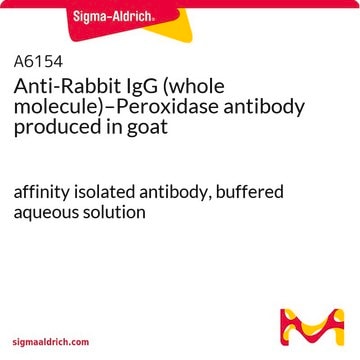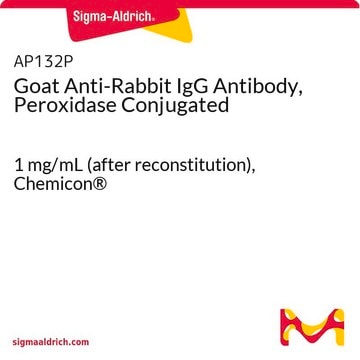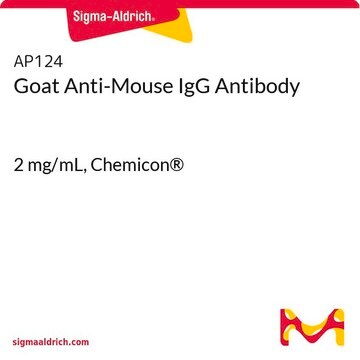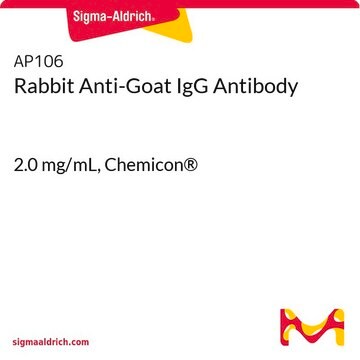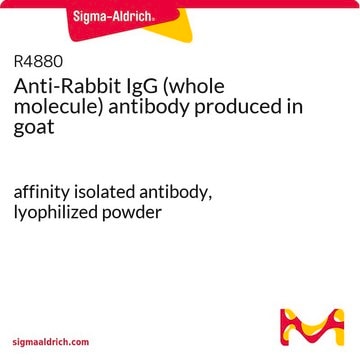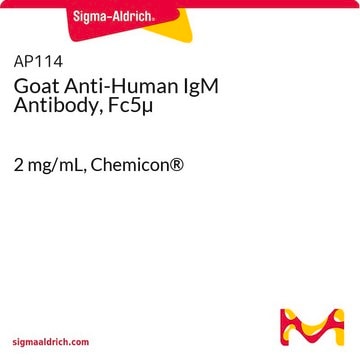AP132
Goat Anti-Rabbit IgG Antibody
2 mg/mL, Chemicon®
Synonym(s):
Anti-Rabbit IgG, Goat Anti-Rabbit IgG
Sign Into View Organizational & Contract Pricing
All Photos(1)
About This Item
UNSPSC Code:
12352203
eCl@ss:
32160702
NACRES:
NA.46
Recommended Products
biological source
goat
Quality Level
conjugate
unconjugated
antibody form
affinity purified immunoglobulin
clone
polyclonal
species reactivity
rabbit
manufacturer/tradename
Chemicon®
concentration
2 mg/mL
technique(s)
ELISA: suitable
immunoprecipitation (IP): suitable
western blot: suitable
shipped in
wet ice
target post-translational modification
unmodified
General description
Immunoglobulin G (IgG), is one of the most abundant proteins in human serum with normal levels between 8-17 mg/mL in adult blood. IgG is important for our defence against microorganisms and the molecules are produced by B lymphocytes as a part of our adaptive immune response. The IgG molecule has two separate functions; to bind to the pathogen that elicited the response and to recruit other cells and molecules to destroy the antigen. The variability of the IgG pool is generated by somatic recombination and the number of specificities in an individual at a given time point is estimated to be 1011 variants.
Specificity
Reacts with Rabbit IgG gamma chain, as well as the light chains from all Rabbit immunoglobulin classes. Monospecific on IEP against whole Rabbit Serum.
Immunogen
Highly purified Rabbit IgG isolated from pooled normal Rabbit Serum.
Application
Goat anti-Rabbit IgG Antibody is an antibody against Rabbit IgG for use in ELISA, IP & WB.
Research Category
Secondary & Control Antibodies
Secondary & Control Antibodies
Research Sub Category
Whole Immunoglobulin Secondary Antibodies
Whole Immunoglobulin Secondary Antibodies
Storage and Stability
Store at +2-8°C.
Legal Information
CHEMICON is a registered trademark of Merck KGaA, Darmstadt, Germany
Disclaimer
Unless otherwise stated in our catalog or other company documentation accompanying the product(s), our products are intended for research use only and are not to be used for any other purpose, which includes but is not limited to, unauthorized commercial uses, in vitro diagnostic uses, ex vivo or in vivo therapeutic uses or any type of consumption or application to humans or animals.
Storage Class Code
13 - Non Combustible Solids
WGK
WGK 2
Flash Point(F)
Not applicable
Flash Point(C)
Not applicable
Certificates of Analysis (COA)
Search for Certificates of Analysis (COA) by entering the products Lot/Batch Number. Lot and Batch Numbers can be found on a product’s label following the words ‘Lot’ or ‘Batch’.
Already Own This Product?
Find documentation for the products that you have recently purchased in the Document Library.
Customers Also Viewed
Fanghao Hu et al.
Nature methods, 15(3), 194-200 (2018-01-16)
Optical multiplexing has a large impact in photonics, the life sciences and biomedicine. However, current technology is limited by a 'multiplexing ceiling' from existing optical materials. Here we engineered a class of polyyne-based materials for optical supermultiplexing. We achieved 20
Justin V Joseph et al.
Cancer letters, 359(1), 107-116 (2015-01-17)
Glioblastoma (GBM) is the most common brain tumor in adults and the mesenchymal GBM subtype was reported to be the most malignant, presenting severe hypoxia and necrosis. Here, we investigated the possible role of a hypoxic microenvironment for inducing a
Soah Lee et al.
Biomaterials, 131, 111-120 (2017-04-07)
Engineering 3D human cardiac tissues is of great importance for therapeutic and pharmaceutical applications. As cardiac tissue substitutes, extracellular matrix-derived hydrogels have been widely explored. However, they exhibit premature degradation and their stiffness is often orders of magnitude lower than
Kenichiro Sakaguchi et al.
Reproductive biology and endocrinology : RB&E, 17(1), 88-88 (2019-11-07)
The antral follicle count (AFC) in mammalian ovaries positively correlates with female fertility. To clarify the causes of differences in fertility between low and high AFC cows, we investigated follicular growth dynamics and hormone concentrations in plasma, follicular fluid, and
Soah Lee et al.
Journal of biomedical materials research. Part A, 104(5), 1064-1071 (2016-01-23)
Smooth muscle tissue is characterized by aligned structures, which is critical for its contractile functions. Smooth muscle injury is common and can be caused by various diseases and degenerative processes, and there remains a strong need to develop effective therapies
Our team of scientists has experience in all areas of research including Life Science, Material Science, Chemical Synthesis, Chromatography, Analytical and many others.
Contact Technical Service


